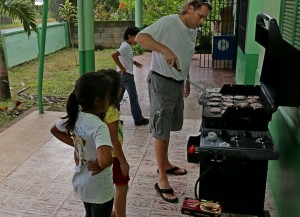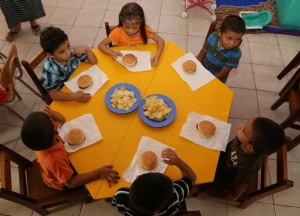Guanacaste Costa Rica Weather and Canadians
The weather in Guanacaste is incredible. I have lived here a long time and I have seen some serious tropical showers; total downpours that would make Noah proud. But a couple Saturdays ago, it had to top the charts. There was so much water, and it came down so fast, that the road in from Sardinal was completely under water in a matter of minutes.
seen some serious tropical showers; total downpours that would make Noah proud. But a couple Saturdays ago, it had to top the charts. There was so much water, and it came down so fast, that the road in from Sardinal was completely under water in a matter of minutes.
As I was driving home my first thought was how thankful I was that I live in Guanacaste where it only rains hard for a couple months, not the entire year like the rest of the country. I couldn’t imagine living with this 75% of the year. (By the way: THEY PAVED MY ROAD!!!!!!!!!!!! My lower back will be forever thankful.) As I pulled into the driveway, there was this glow hovering over my house, and all the dogs were frantically running around in circles, howling in the air, their eyes two inches out of theirs heads. “This can’t be good” I thought. My maid Lorena was waving her hands in the air like she just saw Poltergeist and was mumbling some kind of gibberish that sounded like an  ancient language from King Tut’s tomb. All that my caretaker Pablo could manage to muster up was “Wow, Senor. Wow!!!” It seems my house had suffered a direct hit from a bolt of lightning about 30 seconds before I arrived, and you could immediately smell that horrible stench of burnt electronics. Every one of my canines were climbing over each other to try and get as close to me as possible doing the famous doggie hates thunder dance; walk, shake, pee, shiver; walk, shake, pee, shiver. Little Millie Dolores was vibrating uncontrollably in my arms, as I walked around the property assessing the damage. It was extensive.
ancient language from King Tut’s tomb. All that my caretaker Pablo could manage to muster up was “Wow, Senor. Wow!!!” It seems my house had suffered a direct hit from a bolt of lightning about 30 seconds before I arrived, and you could immediately smell that horrible stench of burnt electronics. Every one of my canines were climbing over each other to try and get as close to me as possible doing the famous doggie hates thunder dance; walk, shake, pee, shiver; walk, shake, pee, shiver. Little Millie Dolores was vibrating uncontrollably in my arms, as I walked around the property assessing the damage. It was extensive.
Guanacaste is known for very powerful and frequent lightning storms, especially in September and October, and most of us sit back and enjoy the show. Nothing is more romantic than hanging in a hammock, sipping on your favorite cocktail or a nice glass of wine; watch the fireworks out in the distance light up the ocean or the volcanoes. But actually, places like Tampa, Florida and Dallas, Texas have way more electrical storms and the odds of getting hit are that much greater there. But this was my lucky day. A bolt of lightning travels at 270,000 miles per hour and can heat the air around it to a deliciously crisp 50,000 degrees Fahrenheit, several times hotter than the surface of the sun. At any one moment there are 1800 thunderstorms in progress around the globe; some 40,000 per day. Every second, 24 hours a day, approximately 100 bolts slam into the ground according to the National Weather Service. So what are the odds that it hit my house? I should be buying LOTTO tickets.
hotter than the surface of the sun. At any one moment there are 1800 thunderstorms in progress around the globe; some 40,000 per day. Every second, 24 hours a day, approximately 100 bolts slam into the ground according to the National Weather Service. So what are the odds that it hit my house? I should be buying LOTTO tickets.
Of course it chose my favorite palm tree,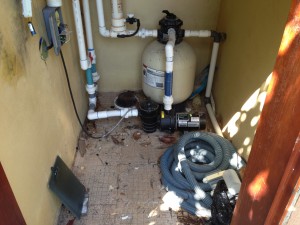 just next to the swimming pool and lifted it two feet out of the ground. If it hadn’t been raining, at least one or two of my dogs would have been taking a dip, cooling off from the heat, and surely would have been instantly evaporated, or at least charred pretty good like a marshmallow left in the campfire a couple seconds too long. It shot down the base of the palm and went in three separate directions. First it went through the pool and into the pump house, blowing the steel door off its frame and melting every pump, timer and mechanism.
just next to the swimming pool and lifted it two feet out of the ground. If it hadn’t been raining, at least one or two of my dogs would have been taking a dip, cooling off from the heat, and surely would have been instantly evaporated, or at least charred pretty good like a marshmallow left in the campfire a couple seconds too long. It shot down the base of the palm and went in three separate directions. First it went through the pool and into the pump house, blowing the steel door off its frame and melting every pump, timer and mechanism.
 The second finger of the bolt found its way into my sprinkler lines, using the moisture as a conduit and proceeded to follow the matrix to every corner of my property. Dozens of my sprinkler heads were shot so far into the air, that we found only pieces of them as they fell back down to earth like hail. I can just see the look on the faces of some NASA geeks when the photos from Mars come back and 6 of them are circling the planet like mini comets. “What the hell is that sir?” Lastly it came across the tile of my patio, leaving a crack over 20 feet long and into the column of my covered terrace, exploding the base as it forced its way into my TV feeds. Any of you who have ever been to my home know that I have a lot of televisions, so you can use your imagination on how easy it found its way through the rest of the house.
The second finger of the bolt found its way into my sprinkler lines, using the moisture as a conduit and proceeded to follow the matrix to every corner of my property. Dozens of my sprinkler heads were shot so far into the air, that we found only pieces of them as they fell back down to earth like hail. I can just see the look on the faces of some NASA geeks when the photos from Mars come back and 6 of them are circling the planet like mini comets. “What the hell is that sir?” Lastly it came across the tile of my patio, leaving a crack over 20 feet long and into the column of my covered terrace, exploding the base as it forced its way into my TV feeds. Any of you who have ever been to my home know that I have a lot of televisions, so you can use your imagination on how easy it found its way through the rest of the house.
After eating every one of the circuit boards in all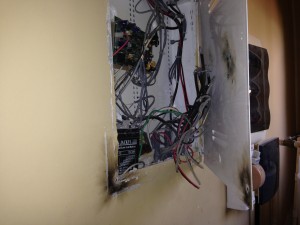 of my audio video equipment, TVs, amps, receivers and speakers, it looked for a way out, and found its exit through my alarm box in the laundry room. The force was so powerful that it shot out the bolts of the metal door that were imbedded into the concrete wall. Imagine how that would have felt if you just happened to be doing a load of laundry at the time and sucked a two inch screw in the side of your head. It continued down the main cable that runs into the house and up the post at the road, completely blowing the meter off and melting the electrical box beyond recognition, before finally exiting the top of the telephone pole. It ended up exploding the transformer while taking out all the electricity for 6 or 7 of the neighbor’s houses. Guanacaste weather can do some serious damage. It was literally like something out of the movie Ghostbusters. As you can guess I was pretty devastated and wallowing in my own self
of my audio video equipment, TVs, amps, receivers and speakers, it looked for a way out, and found its exit through my alarm box in the laundry room. The force was so powerful that it shot out the bolts of the metal door that were imbedded into the concrete wall. Imagine how that would have felt if you just happened to be doing a load of laundry at the time and sucked a two inch screw in the side of your head. It continued down the main cable that runs into the house and up the post at the road, completely blowing the meter off and melting the electrical box beyond recognition, before finally exiting the top of the telephone pole. It ended up exploding the transformer while taking out all the electricity for 6 or 7 of the neighbor’s houses. Guanacaste weather can do some serious damage. It was literally like something out of the movie Ghostbusters. As you can guess I was pretty devastated and wallowing in my own self 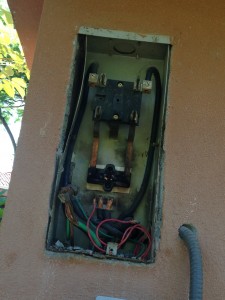 pity shortly there after, but things got put into perspective when I went to get a pizza a couple hours later.
pity shortly there after, but things got put into perspective when I went to get a pizza a couple hours later.
There is this very poor family who lives in a shack on a farm just a couple minutes from my house. I always stop and give them bags of food for their dogs. As I passed I saw the entire family out in front, desperately sweeping with brooms to keep the impeding river that had formed from the rain, from completely consuming their home. My “Whoa Me” attitude immediately went right out the window; I am truly very lucky. Pablo, Lorena and all my street mutts are ok, and that is really all the matters. Everything else is just materialistic junk and it can be replaced.
Lorena and all my street mutts are ok, and that is really all the matters. Everything else is just materialistic junk and it can be replaced.
People always beat up on Costa Rica and talk about how slow everything is, how everyone has a Manana attitude, blah blah blah. Well let me tell you something. The electric company had a repair crew at my house first thing Monday morning, along with my electricians, and they restored power back to the house in a couple of hours. Sure the A/C was fried along with so many other things, but those all got replaced or repaired in a couple days as well. By the following Friday everything was back to normal, minus the replacement of my electronics. I have clients in Oklahoma who still don’t have power back to their homes from the tornadoes and another whose building in New York City is still surviving on a generator after more than a year since the arrival of Sandy. So I say; give Costa Rica some credit. I guess this was God’s way of telling me that I really need 12 new Hi Def TVs and that new 80 inch Samsung I have been looking at on line! Time to go SHOPPING!!!!!
 One of the first phone calls I got was from my buddy Michael Mills, a Canadian from British Columbia. “We have a spare bedroom buddy and a fridge full of Pilsens, so if you need a place to crash you are more than welcome. Just bring Millie Dolores” he said. Michael came down here 15 years ago and just never left, like quite a few other people, and started referring clients to my office soon after. He operated a sail boat and he was sending so many buyers my way, I finally convinced him to sell the damn hull in the water and join our team, and he is now my partner at Prestige Ocean Properties. Without a doubt, one of the finest people I have ever met in my life, and one of the many Canadians I call my friends down here in paradise.
One of the first phone calls I got was from my buddy Michael Mills, a Canadian from British Columbia. “We have a spare bedroom buddy and a fridge full of Pilsens, so if you need a place to crash you are more than welcome. Just bring Millie Dolores” he said. Michael came down here 15 years ago and just never left, like quite a few other people, and started referring clients to my office soon after. He operated a sail boat and he was sending so many buyers my way, I finally convinced him to sell the damn hull in the water and join our team, and he is now my partner at Prestige Ocean Properties. Without a doubt, one of the finest people I have ever met in my life, and one of the many Canadians I call my friends down here in paradise.
You see, it seems I hurt some people’s feelings with my comments about Cheap Canadians, Buffalo and Cleveland in my Newsletter a couple of weeks ago. Well, if it truly offended you I am sorry, but seriously everyone, this is just a Newsletter. If you want someone to hold your hand and sing Kumbaya, you’ve got the wrong guy. There is a reason I have never been married, I am just not the cuddly / feely / hold you kind of dude: I was a Marine Drill Sergeant in my previous life before being reincarnated as a realtor in paradise. And if I get to come back again, I plan to be an NFL coach in the mold of the three Bills: Parcells, Belichick and Cowher so get used to it.
but seriously everyone, this is just a Newsletter. If you want someone to hold your hand and sing Kumbaya, you’ve got the wrong guy. There is a reason I have never been married, I am just not the cuddly / feely / hold you kind of dude: I was a Marine Drill Sergeant in my previous life before being reincarnated as a realtor in paradise. And if I get to come back again, I plan to be an NFL coach in the mold of the three Bills: Parcells, Belichick and Cowher so get used to it.
Personally, I love Canadians; I should have been one myself. In my first business many moons ago, I partnered with two guys from Hamilton, Ontario, and they proceeded to sit me down for a talk before we got started. “There are two things you need to know if we are going to work together” they told me. “One: We only drink Moosehead beer and Two:  We watch hockey” and I have been enjoying them ever since. To this day, I am still great friends with both of these guys, and the majority of my sports travels have been with my good buddy Brad; otherwise known as Super Cooper.
We watch hockey” and I have been enjoying them ever since. To this day, I am still great friends with both of these guys, and the majority of my sports travels have been with my good buddy Brad; otherwise known as Super Cooper.
As far as Buffalo and Cleveland goes? Well, I have a friend from Ohio whom I met at the Super Bowl a few years ago; he came down and bought a beautiful Pacifico condo. He invited me to go to a Browns game the end of this month, so I am going to hold off on my final comments until I get back. But Buffalo? Sorry, I have been there; I rest my case. There just isn’t anything you can say. It’s a dump; may it rest in peace with Detroit.
Costa Rica is loaded with some great Canadians. My neighbor Jerry is the one of the best guys on the planet. He was one of the largest Real Estate brokers in Ontario and we met at a convention in Atlanta 6 or 7 years ago. He literally was in my face everyday, adamant that he was going to come down and buy a place. Not one week after the show, he arrives into Liberia airport and I picked him up. First words out of his mouth? Where do you live? If it’s good enough for you he said it’s good enough for me, and he bought the house next door, and we have been best buddies ever since. For a house warming gift I bought him a pathway, so we can go back and forth to each others homes, without having to go down the driveway. You couldn’t ask for a better neighbor. He is the first guy to pay and the last guy to complain and he has the most amazing family, but most important of all; he loves my dogs and they love him too. Cracker please Uncle Jerry. When his better half Diane goes back to visit the grandkids, I become his surrogate wife. I have
My neighbor Jerry is the one of the best guys on the planet. He was one of the largest Real Estate brokers in Ontario and we met at a convention in Atlanta 6 or 7 years ago. He literally was in my face everyday, adamant that he was going to come down and buy a place. Not one week after the show, he arrives into Liberia airport and I picked him up. First words out of his mouth? Where do you live? If it’s good enough for you he said it’s good enough for me, and he bought the house next door, and we have been best buddies ever since. For a house warming gift I bought him a pathway, so we can go back and forth to each others homes, without having to go down the driveway. You couldn’t ask for a better neighbor. He is the first guy to pay and the last guy to complain and he has the most amazing family, but most important of all; he loves my dogs and they love him too. Cracker please Uncle Jerry. When his better half Diane goes back to visit the grandkids, I become his surrogate wife. I have  him over for dinner and I cook for him. We eat man food though, like tacos, meatloaf and Sloppy Joe’s, and sit around in the pool all day drinking beer, sipping Canadian Club and watching hockey. I guess that’s why I am not married. I love that I can eat what I want, drink what I want, go where I want and do whatever I want, and I never have to answer to anyone. Jerry roots for my New York teams and I root for his Maple Leafs. It’s a hell of a relationship.
him over for dinner and I cook for him. We eat man food though, like tacos, meatloaf and Sloppy Joe’s, and sit around in the pool all day drinking beer, sipping Canadian Club and watching hockey. I guess that’s why I am not married. I love that I can eat what I want, drink what I want, go where I want and do whatever I want, and I never have to answer to anyone. Jerry roots for my New York teams and I root for his Maple Leafs. It’s a hell of a relationship.
Through Jerry I met Ed and his wonderful wife Carolyn. Let me tell you how generous these Winnepeggers are. Last year, they took all the net profit from their condo rentals and donated it to the local charity that helps poor children obtain back packs for Christmas, loaded with all their school supplies and uniforms. There is not a bigger heart in the world. Who does that? Only a Canadian. Unfortunately, many Canadians ARE cheap, I hate to say it. When the bar tab comes, they scamper like mice, off to the bathroom or pretending to be talking on the phone, and the Americans usually get stuck paying the bill. But not Ed. He took a whole bundle of us out one night for dinner, and the tab was well over $1000 and he refused to let any of us contribute. Most of the charities in town are organized by Canadians, and they spend the majority of their time helping others. Anna at the clinic, Gary with the school, Joselyn and Sylvie with the girl scouts; I could go on for hours about these incredible Canadians and how they go out of their way to help the less fortunate. Claude and his lovely wife Silvia, known by many as the Mayor of Hermosa, are the founders of the Playa Hermosa Association, which does everything from cleaning the beaches, to rescuing monkeys and planting new trees as well. God Bless em.
bundle of us out one night for dinner, and the tab was well over $1000 and he refused to let any of us contribute. Most of the charities in town are organized by Canadians, and they spend the majority of their time helping others. Anna at the clinic, Gary with the school, Joselyn and Sylvie with the girl scouts; I could go on for hours about these incredible Canadians and how they go out of their way to help the less fortunate. Claude and his lovely wife Silvia, known by many as the Mayor of Hermosa, are the founders of the Playa Hermosa Association, which does everything from cleaning the beaches, to rescuing monkeys and planting new trees as well. God Bless em.
 There are so many great Canadians, you gotta get down here and meet them. Daryl and Cheryl, Nadene and Roland, Herb and Donna, John and Faith; they are all from Calgary. We got the French Canadians too; Alain, Richard, Clermont and their beautiful wives, but Jean Pierre will always have a special place in my heart. He floated down here on a sail boat 26 years ago and just never left. He bought a little house on the beach and built it into a 22 room lodge called the El Velero, one of my favorite places on earth. He then sold it to another Canadian, Big Mike and his wife Leslie. As anyone who has ever spent 5 minutes with me knows, this hotel is my second office, where I spend almost every morning enjoying my breakfast on the beach and every afternoon sucking back cocktails for sunset. Even my partner Chris and his daughter Lisa are from Vancouver; I can honestly say that if it wasn’t for Canadians I wouldn’t be here. Possibly my all time
There are so many great Canadians, you gotta get down here and meet them. Daryl and Cheryl, Nadene and Roland, Herb and Donna, John and Faith; they are all from Calgary. We got the French Canadians too; Alain, Richard, Clermont and their beautiful wives, but Jean Pierre will always have a special place in my heart. He floated down here on a sail boat 26 years ago and just never left. He bought a little house on the beach and built it into a 22 room lodge called the El Velero, one of my favorite places on earth. He then sold it to another Canadian, Big Mike and his wife Leslie. As anyone who has ever spent 5 minutes with me knows, this hotel is my second office, where I spend almost every morning enjoying my breakfast on the beach and every afternoon sucking back cocktails for sunset. Even my partner Chris and his daughter Lisa are from Vancouver; I can honestly say that if it wasn’t for Canadians I wouldn’t be here. Possibly my all time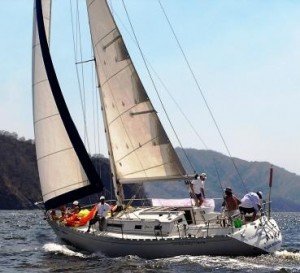 favorite Canadian is my good friend Cheryl. She moved down here as a very young woman and started one of the most successful rental agencies in town. Aside from being incredibly beautiful, inside and out, she is just one of the neatest people you will ever meet, and a fantastic business woman. She is probably the most eligible bachelorette in Costa Rica, but guys you have no chance. I mean, if I couldn’t close the deal and win her over, you ain’t got a prayer LOL.
favorite Canadian is my good friend Cheryl. She moved down here as a very young woman and started one of the most successful rental agencies in town. Aside from being incredibly beautiful, inside and out, she is just one of the neatest people you will ever meet, and a fantastic business woman. She is probably the most eligible bachelorette in Costa Rica, but guys you have no chance. I mean, if I couldn’t close the deal and win her over, you ain’t got a prayer LOL.
So many of these people all seem to have a similar story. They came down on vacation, fell in love with paradise, and never left. I find it intriguing when people try to deter someone from chasing their dreams. Maybe they are jealous of how happy we are here, or maybe they are just so miserable that they have to find something wrong with everything. Last week an article came out and it was pathetic how many people forwarded it to me or posted it on my Facebook. It was as if they wanted, NEEDED to find a 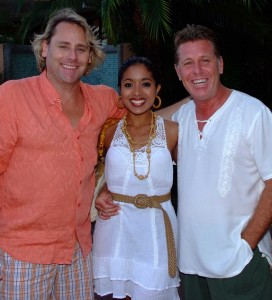 reason to justify their fear of moving here or try to stop someone else from living out their dream. It is baffling how many people spend their entire waking moments focusing on negative stuff; I just don’t have time for it, I am too busy enjoying life. The article said that it was cheaper to retire in Alberta than Costa Rica; some magazine had done a big study. My first thought was; where is Alberta? Seriously, who on Gods green earth wants to live where it is dark half the year and 40 degrees below zero? You need a dog sled to go to the grocery store, but HEH, ITS CHEAP!!! I guess Arctic living is a real bargain these days. I wonder if realtors send out coupons in the mail; BUY ONE IGLOO GET THE SECOND ONE FREE.
reason to justify their fear of moving here or try to stop someone else from living out their dream. It is baffling how many people spend their entire waking moments focusing on negative stuff; I just don’t have time for it, I am too busy enjoying life. The article said that it was cheaper to retire in Alberta than Costa Rica; some magazine had done a big study. My first thought was; where is Alberta? Seriously, who on Gods green earth wants to live where it is dark half the year and 40 degrees below zero? You need a dog sled to go to the grocery store, but HEH, ITS CHEAP!!! I guess Arctic living is a real bargain these days. I wonder if realtors send out coupons in the mail; BUY ONE IGLOO GET THE SECOND ONE FREE.
People ask me all the time, “how long did it take you to adjust?” Hmmmmmmmm. Five minutes. No kidding. Costa Rica weather is warm, and I like tropical. Costa Rica has cold beer; count me in. Gorgeous beaches? Check. Beautiful people? Best in the world. Yup. I’m adjusted. I might not be the smartest guy in the world but I have always had the ability to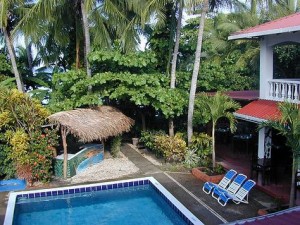 just make a decision. So many people spend so much time TRYING to find a reason NOT to do something. I have never been that way; I have always been a see it / act on it kind of guy. I knew within 5 minutes of my first beer at El Velero I was going to love Costa Rica and I wanted to live here. I didn’t need to test the water for a year to see if I could handle it. I knew it was for me. I didn’t worry about all the stories you hear on line of the people who supposedly came here and couldn’t make it, I don’t compare myself to failures. Besides why would you spend time reading about it, when you can just come here and see for yourself? That’s like trying to learn about animals by visiting the zoo or watching Discovery Channel. You gotta get out into the jungle. Too many people live in a crawlspace, I feel sorry for people who can’t make up their minds.
just make a decision. So many people spend so much time TRYING to find a reason NOT to do something. I have never been that way; I have always been a see it / act on it kind of guy. I knew within 5 minutes of my first beer at El Velero I was going to love Costa Rica and I wanted to live here. I didn’t need to test the water for a year to see if I could handle it. I knew it was for me. I didn’t worry about all the stories you hear on line of the people who supposedly came here and couldn’t make it, I don’t compare myself to failures. Besides why would you spend time reading about it, when you can just come here and see for yourself? That’s like trying to learn about animals by visiting the zoo or watching Discovery Channel. You gotta get out into the jungle. Too many people live in a crawlspace, I feel sorry for people who can’t make up their minds.
 As they say in The Shawshank Redemption: You gotta get busy living or get busy dying. I’ll take the living part, thank you very much. Costa Rica is not cheap, but it surely isn’t expensive, and there is so much more to this place than the cost of electricity or Haagen Dazs ice cream. It’s about quality of life, friendships and good times. It’s about Pura Vida and this amazing lifestyle. If you want cheap, I guess you gotta move to Canada. Say hello to the Walruses for me.
As they say in The Shawshank Redemption: You gotta get busy living or get busy dying. I’ll take the living part, thank you very much. Costa Rica is not cheap, but it surely isn’t expensive, and there is so much more to this place than the cost of electricity or Haagen Dazs ice cream. It’s about quality of life, friendships and good times. It’s about Pura Vida and this amazing lifestyle. If you want cheap, I guess you gotta move to Canada. Say hello to the Walruses for me.
Well, there is another rain storm brewing in the distance, but I’m not worried about the weather. They say lightning never strikes twice so I know now that I am bulletproof. I think I am just going to grab myself a cold Pilsen, take the dogs for a walk while swinging my golf club in the air. Bring it on man, bring it on! Hockey season starts soon too so I gotta run, gotta practice my singing to make Jerry proud. “Oh Canada, Our Home and Native Land.” Take care. Hope to see you soon. Hurry down.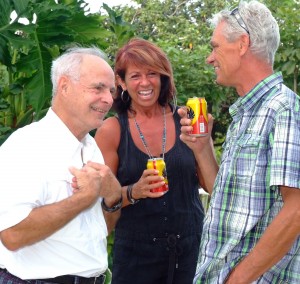
Michael
P.S. A few weeks ago, one of the greatest Canadians I have ever known died suddenly in a small plane crash. Riki Gourgeon was the most positive, upbeat, energetic man I have ever met. He just willed people to succeed and you wanted to be around him. I miss you my friend. R.I.P. Thanks for all your advice and support.
God Bless You and your family.
Tank Tops Flip Flops Newsletter edition no. 27
Link to all Prior Newsletters
If you have had a great experience with my office and Costa Rica, I want to hear about it. Please send us a video of yourself telling us WHY and I will post it to my website for everyone to see. Or send me an email and I will put it in my Testimonials. I appreciate your business and that you have decided to read this Newsletter more than I could ever tell you. THANK YOU. Please take a little more time and check out the entire site. We have added a lot of information lately that I am sure you will find helpful. Also, please forward this to any friends you think might be interested in learning more about Costa Rica. Is there a story behind Tank Tops and Flip Flops you ask? Of course, but you have to stay tuned for another Newsletter. I hope all is well. Stay healthy. God Bless you and your families. Stop procrastinating and hurry back!




